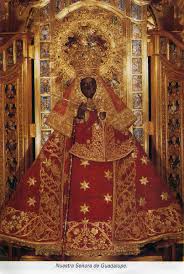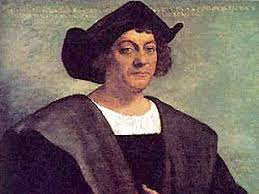Back in the early 1990’s, I had the privilege of serving as associate producer for a four-hour television documentary that encompassed the evangelization of Europe and the efforts to bring Christianity to the New World. Called River of Light, it was produced by British film maker, John Bird, and was part of a series of films he produced about Our Blessed Lady.
Light, it was produced by British film maker, John Bird, and was part of a series of films he produced about Our Blessed Lady.
Part of my assignment was to join the crew for eight days in Spain where they were producing some key segments for the documentary. It was a blessed experience in many ways and on many levels. One of the most significant moments for me came when we visited the Monastery of Our Lady of Guadalupe, located in the Estremadura in the village of Guadalupe.
What I didn’t realize but came to know was that Our Lady of Guadalupe played a significant role in the life of Christopher Columbus and in the founding of the New World.
As our van jogged and bumped over the ancient Roman road, I thrilled to the thought that so many conquistadors and saints of the Church had probably traveled this same path. My imagination pictured some of the greats, but soon I became captivated by the story John was telling about the place we were going to visit. Significant events, which centuries later would impact my own life, unfolded there.
The story dates back all the way to St. Luke the Evangelist and a tiny statue of the Blessed Mother that legend tells us he carved out of black cypress wood. The sculpture had been given to Bishop Leander of Seville by Pope Gregory the Great (540 -604) and was much revered by the people of Spain. In fact, many miracles had been attributed to it.
When Islamic rule won the day in Spain through the Moors, a group of knights who were very concerned with the preservation of national treasures including those of great religious significance, took the statue with them on their journey to Austria. Threatened with death and annihilation, they placed the statue in an iron casket and buried it somewhere in a cave in the province of Estremadura in Northern Spain. All of them were eventually killed and the location of the burial site died with them.
Fast forward to 1326. Religious devotion to Our Blessed Lady had increased in the intervening years largely strengthened by the hardships imposed upon the Christians under the Islamic rule of the Moors. When the country finally gained liberation, love of the Madonna was deeply ingrained in the hearts of the people.
 By this time Spain was already established as a major power, but a power that recognized the spiritual protection of the Blessed Mother as a cause of her success. In that year an unassuming cowherd from the Estremadura named Gil reported that Our Lady had appeared to him and encouraged him to have the ecclesiastical authorities dig at the site of the apparition.
By this time Spain was already established as a major power, but a power that recognized the spiritual protection of the Blessed Mother as a cause of her success. In that year an unassuming cowherd from the Estremadura named Gil reported that Our Lady had appeared to him and encouraged him to have the ecclesiastical authorities dig at the site of the apparition.
Intrigued with his story, Gil was able to convince the priests from nearby Guadalupe to come to the site. They soon excavated the iron casket with the tiny statue within it — 600 years after it had been buried by the Knights of Don Rodrigo during their hurried flight from Spain. After documents established the authenticity of the perfectly preserved statue, a small shrine was built on the spot and the image was entrusted to the custody of the Franciscan friars. Knowledge of the statue’s discovery quickly traveled through all of Spain and soon many pilgrims made their way to the small town where Our Lady’s image, now called Our Lady of Guadalupe, had found a home.
In 1340, King Alfonso XI started to take a personal interest in the image of the Blessed Mother and the shrine that housed her. This largely stemmed from his victory over the Moors at the Battle of Rio Salado which he attributed to the Virgin’s intercession. Under his influence, the tiny shrine soon grew to a monastery which was built by Moorish masons who had converted to Christianity. It remains one of the most architecturally interesting structures in Spain.
King Alfonso XI was not the only dignitary to benefit from the tranquil environ of the monastery and from the intercession of the Blessed Mother who seemed to make her presence known by way of her lovely sculpted image. Many royals from other countries visited the Monastery and sent beautiful gifts of jewel-encrusted clothing to dress the tiny image of Our Lady. In addition, numbers of conquistadors visited the monastery and carried a replica of Our Lady’s image with them on their journeys.
And this brings us to 1492 and the visit of Queen Isabella of Spain. An Italian sailor and map maker by the name of Christopher Columbus had come to the court of Spain to seek patronage and ships for exploration. King Ferdinand and  Queen Isabella listened to Columbus’ plea but eventually refused his request. Three times.
Queen Isabella listened to Columbus’ plea but eventually refused his request. Three times.
However, something about the Italian sailor and something about his vision was not as easily refused. The Queen decided she needed to pray through his request for Spain’s patronage and the place to do it was the Monastery of Guadalupe. And the one whose intercession she sought to implore was the Madonna from whom her own kingdom had benefited so powerfully.
Queen Isabella came home from her retreat convinced that Spain should send Christopher Columbus on his voyage and that he should make a retreat at the Monastery before his departure. Columbus was delighted with the news and set off for Guadalupe to seek the prayerful intercession of the Woman whose image the tiny statue represented. Columbus returned to Spain encouraged and embolded. He named his vessel the Santa Maria in honor of Our Lady of Guadalupe and sailed under her banner.
Life at sea was no easy feat in those days. Disease, pirates, and weather were the most common enemies of the sailor. And voyages could be plagued by many other maladies as well. Columbus experienced his fair share including the stealing of one of his ships by an insurgent captain and the grounding of his flagship, the Santa Maria, on a reef.
When Columbus returned to Spain, he made his way to the Monastery of Guadalupe to make a retreat of thanksgiving and to express his gratitude to Our Lady for her intercession and maternal protection. He took with him to the Monastery the Native Americans who had traveled back to Spain under his care. And there, in the public square, using the water issuing forth from its fountain, these first travelers of the new land received the Sacrament of Baptism. 
Fast forward yet again to 1992, and there I was, some 550 years later, standing in the very place where my national history traced its roots. As I knelt before the statue of Our Lady in the Monastery of Guadalupe, in perhaps the very spot where Queen Isabella and Christopher Columbus had knelt half a millenium before, I was filled with awe, with gratitude, and with a profound sense of the Blessed Mother’s love for us and for this, our nation, so intimately connected to her.
In this our day and time, we need Our Holy Mother’s prayerful intercession now more than ever. She has been with us since our beginnings and she is with us still. Let us never forget to seek her help. And let us never forget to thank God that He has given us the grace to do so.
And now, in the words of the late Paul Harvey, you know the rest of the story.









